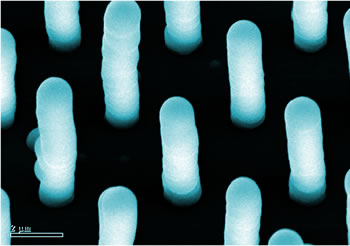What is Nanotechnology?

Array of vertically aligned carbon nanotubes
Nanotechnology is a broad term that covers many areas of science, research and technology. In its most basic form, it can be described as working with things that are small. Things so tiny that they can't be seen with standard microscopes. The same stuff that has always been there, but we just couldn't see it. The building blocks of nature, atoms and molecules. Nano-technology involves understanding matter at the "nano" scale.
A nanometer is one-billionth of a meter. In comparison, a human hair is about 100,000 nanometers in diameter.

New types of imaging tools, like the atomic force microscope, have allowed scientists to peek into the nano world. A world that before could only be visualized in theory. These tools help scientists validate theories about the way that atoms group together to form molecules of different types and shapes.
"Consider the element carbon at the nanoscale. In nature, when carbon atoms are arranged one way you get a diamond. If they're put together another way, you get graphite." - Eleanor Imster, Earth and Sky Radio Series
The discovery in 1985 of buckminsterfullerene (buckyball), opened a new era for the chemistry of carbon and for novel materials. The Japanese Sumi Ijima discovered nanotubes in 1991.
The transition of nanotechnology research into manufactured products is limited today, but some products moved relatively quickly to the marketplace and already are having significant impact.
The “jumbotron lamp,” that lights many of today's athletic stadiums is a nanotube-based light source. Additional products available today that benefit from the unique properties of nanoscale materials include: bumpers on cars, sunscreens and cosmetics, stain-free clothing and more.
New applications of nanotechnology that are expected in two to five years are:
• Implantable devices that automatically administer drugs and sense drug levels.
• Cancer tagging mechanisms and
real time diagnostics for physicians.
• Sensors for airborne chemicals or other toxins.
• Improved solar cells and fuel cells
• Faster, smarter and inexpensive computers.
The power of nanotechnology is in the manipulation of materials at the nanoscale. This enables scientists to alter the properties of materials to make them do new things and to invent materials not found in nature.
http://www.futureforall.org/nanotechnology/nanotechnology.htm
No comments:
Post a Comment